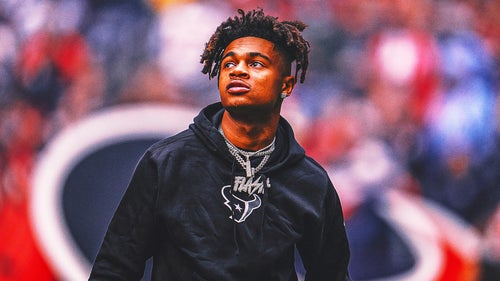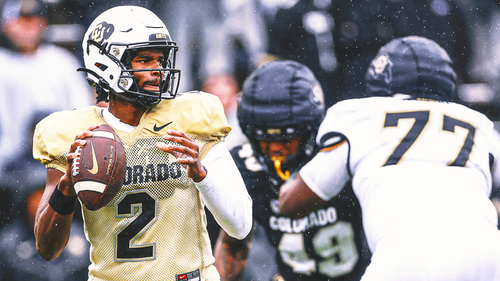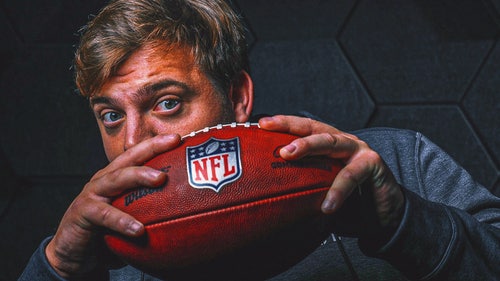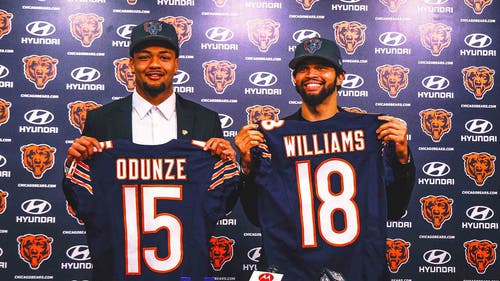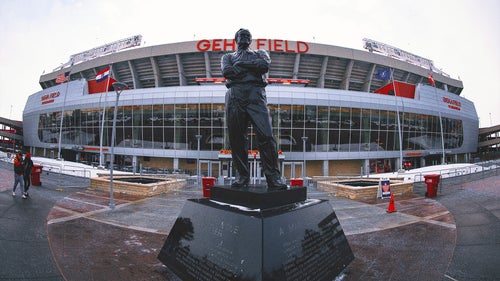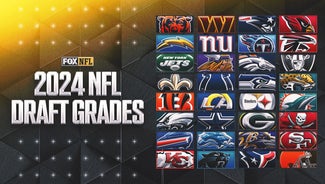
Sometimes a fight can start with a call
You have to hand it to 49ers coach Jim Harbaugh for a couple of reasons.
One good, one not so good.
First, the good: By beating the previously unbeaten Lions, 25-19, in Detroit, the 49ers have probably been the NFL’s biggest shock this season. The Lions, too, have surprised, but everyone knew the Lions had loads of talent. While I know Harbaugh was a very successful coach at Stanford, the emotional first-year NFL coach has helped lead the 49ers to a 5-1 record that nobody could have predicted.
Now, for the not so good: Harbaugh was so excited by the victory, he ran across the field to shake Lions coach Jim Schwartz’s hand, but in his exuberance, grabbed Schwartz’s hand really hard and also slapped him rather hard on the back. Schwartz took exception to both and chased Harbaugh, bumping into him as the two were running off the field. The coaches had to be separated by a large group of players from both sides.
I understand the emotion felt by Harbaugh after winning this game, especially another impressive road win. I do, however, think that Harbaugh went too far with his gyrations coming across the field the way he did. Emotion is emotion, but coaches need to show greater respect for their opponents, both coaches and players.
But I want to go back to something that happened near the end of the first quarter that may have caused what transpired at the end of the game between Harbaugh and Schwartz.
Detroit had the ball, third-and-10 from the San Francisco 16-yard line with 4:44 left in the first quarter. Lions quarterback Matthew Stafford threw 16 yards to Brandon Pettigrew for a touchdown.
As he was being tackled by Patrick Willis, Willis stripped the ball out of Pettigrew’s hands, but Pettigrew was already down. Harbaugh tried to challenge the ruling, but was penalized for unsportsmanlike conduct.
While replay did its job on this play, confirming the ruling, Harbaugh attempted to challenge the ruling on the field and was hit with the penalty. Coaches are not allowed to challenge inside of two minutes if they are out of challenges, if they are out of timeouts or if a play is ruled a score.
Harbaugh deserved the penalty, but didn’t deserve the verbal abuse that came from the Lions coach on the other sideline. Schwartz was seen on television mocking Harbaugh by yelling something like, "Know the rules," except with a little off-color language thrown in.
Although Harbaugh denied seeing it, it makes me wonder whether the ill will didn’t start right there. Because with as many television cameras that cover the NFL these days, everybody sees everything. And I’m sure someone must have told him.
One thing Harbaugh needs to remember: As emotional as he was with winning, he’s got to understand that the losing team’s sentiment is quite the opposite.
I’m not sure what will come of this from the league office, but I suspect that both coaches will get letters warning them that this behavior is not acceptable and any further acts that are similar to this will lead to fines and possible suspensions.
There were so many interesting calls in the San Francisco-Detroit game, I probably could have spent the entire column on this contest. I’ll highlight two plays in particular — first, San Francisco’s game-winning touchdown with 1:51 left in the fourth quarter.
Detroit was leading, 19-15, but the 49ers had the ball, fourth-and-6 from the Detroit 6-yard line. San Francisco quarterback Alex Smith’s 6-yard pass to Delanie Walker was complete for a touchdown. The replay assistant initiated a review, questioning whether the runner broke the plane, and the play was upheld.
I know we all have a tendency to emphasize mistakes that officials make on the field, but we often forget how difficult these calls are when they have to be made in real time. This was an example of a really good call when the officials ruled a touchdown for the ball breaking the plane before Walker’s knee or shin was down.
This play was reviewed, and referee Mike Carey stayed with the call of a touchdown. The down-the-line shot provided by FOX showed that Walker’s knee was still barely off the ground when the ball broke the plane. It was a terrific ruling live on the field and a good use of replay.
The other sequence that stands out in that game was when Detroit scored the go-ahead touchdown in the fourth quarter, a play that had déjà vu written all over it — think Calvin Johnson from 2010 — except this time with a positive outcome for the Lions.
San Francisco was leading, 15-13, and the Lions had the ball, second-and-5 from the San Francisco 5-yard line with 14:13 left in the fourth quarter.
The Lions’ Stafford completed a pass to Nate Burleson in the end zone for what appeared to be a touchdown, but the play was ruled incomplete. As Burleson caught the ball, he got both feet down and was pushed out of bounds by the 49ers’ Carlos Rogers. Detroit challenged the incomplete pass ruling, the play was reversed and Lions were awarded a touchdown.
I didn’t think referee Carey would overturn the call on the field of an incomplete pass, but he did and I’m glad.
It’s hard for people to understand how this can be a touchdown and the play last year with Johnson against Chicago in Week 1 was not. There are a lot of similarities in these two plays, but to me, Johnson was going to the ground on his own, more so than Burleson, who seemed to be aided by a push from Rogers.
I think what Carey did is what the competition committee really wanted to do during this past offseason, which was to use common sense and view the play like most NFL fans saw it.
Whew. Let’s now take a look at a few of the other interesting plays around the league.
THE GAME: St. Louis at Green Bay
THE SITUATION: St. Louis had the ball, second-and-10 at the Green Bay 42-yard line with 10:30 left in the second quarter. Green Bay led 10-0.
THE PLAY: St. Louis quarterback Sam Bradford was sacked by A.J. Hawk. Television cameras picked up Hawk giving the bird (middle finger) to someone, but he was not flagged for it.
MY TAKE: The league is not going to like this. This was not seen by the officials, and some people feel like it was OK because it was directed at his own team.
Guess what? Michael Vick flipped off his own fans when he played for the Atlanta Falcons, and it cost him $20,000. Flipping the bird to anyone is not going to be deemed acceptable by the NFL. Once again, it proves there is very little you can get away with when you have a game with tons of cameras.
THE GAME: Dallas at New England
THE SITUATION: New England had the ball, first-and-5 at the Dallas 5-yard line with 7:34 left in the second quarter. New England led 6-3.
THE PLAY: New England quarterback Tom Brady passed to Wes Welker for four yards and was ruled short of the end zone. But Welker was diving for the goal line and appeared to have reached the ball over the pylon. New England challenged the ruling on the field, and the call was reversed.
MY TAKE: This was a play where referee Walt Coleman had to piece two shots together to conclude that this was a touchdown. The goal line no longer extends "around the world." Therefore, when Welker was going from the field of play out of bounds, he had to reach the ball back over the top or inside the pylon.
The shot looking in from the corner of the end zone showed that Welker had extended the ball forward before actually stepping out of bounds. But you didn’t get a perspective of whether the ball got over or inside the pylon. The goal line shot showed that when Welker extended the ball, it had gone far enough to break the plane.
When you combined the shots to see the extension, and then where the ball was when the extension occurred, it was enough to overrule the call on the field to a touchdown. It’s tricky when you have to use two shots to come up with one conclusion.
THE GAME: Philadelphia at Washington
THE SITUATION: Philadelphia had the ball, second-and-12 at the Philadelphia 16-yard line with 11:15 left in the first quarter. There was no score.
THE PLAY: A bad snap from center had quarterback Michael Vick scrambling to pick up the ball around the end zone line. Vick picked it up and threw an incomplete pass. Washington was flagged for roughing the passer.
MY TAKE: This was a tough play to officiate because it involves roughing the passer and intentional grounding. Clearly it’s a foul for roughing the passer as even a scrambling quarterback gets helmet-to-helmet protection.
A harder call was the lack of intentional grounding. Vick picked up the ball while still in the pocket, but then moved to his left and appeared to get outside the pocket. The ball was snapped on the left hash mark, and the pocket only extends to the outside foot of the left tackle. Once you get outside this pocket, you can throw the ball away as long as you get it back to the line of scrimmage. I think the officials did a good job on this play.
THE GAME: Houston at Baltimore
THE SITUATION: Houston had the ball, fourth-and-4 at the Houston 26-yard line with 3:06 left in the fourth quarter. Baltimore led 26-14.
THE PLAY: Houston quarterback Matt Schaub completed a 4-yard pass to Jacoby Jones for a first down. Baltimore challenged the first down ruling, and the play was reversed.
MY TAKE: Many of my Twitter followers chimed in on this play, asking why the pass was overturned to incomplete. The referee announced that the receiver’s right foot was on the foot of the defender and never touched the ground.
Well, it did touch the ground. There was one field-level shot that showed Jones’ right toe was on the ground. My suspicion is that referee was never shown this shot.
There are so many replays that do get shown, but it is up to the replay team in the press box to make sure they get the right shot, even if that shot comes when they are already in review. It’s unfortunate, but I think they’ll look back on this and say they didn’t get the best shot for the referee to view.
It was a catch, and I also think that Jones controlled the ball at a spot that would have given him a first down.
THE GAME: Philadelphia at Washington
THE SITUATION: Washington had the ball, third-and-16 from the Philadelphia 38-yard line with 12:02 left in the first quarter. There was no score.
THE PLAY: Washington quarterback Rex Grossman’s pass intended for Fred Davis was intercepted by Kurt Coleman. His momentum appeared to carry him into the end zone, but it was ruled that he was down at the 3-yard line. With an unnecessary roughness called on the Redskins, Philadelphia was given the ball at the 18-yard line.
MY TAKE: There were a couple of plays Sunday that involved the momentum rule. Momentum applies on interceptions, fumble recoveries and kick catching. If a defensive player intercepts a pass moving toward his own goal line, and he gets both feet down in the field of play and then his momentum takes him into the end zone, he’s entitled to the ball at the spot where he completes the interception. That’s where the second foot comes down. This was a perfect example of the momentum rule. Since your original momentum takes you into the end zone, it’s almost treated as a forward-progress spot.
You can follow Mike Pereira on Twitter right here.






































































































































